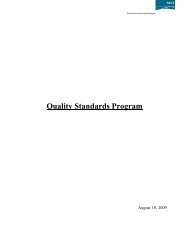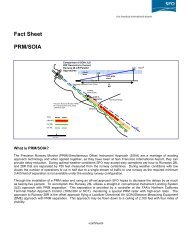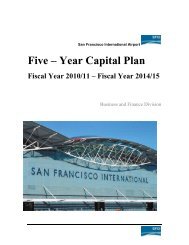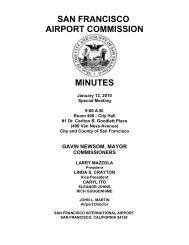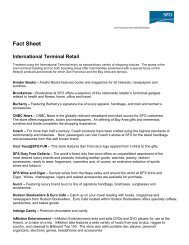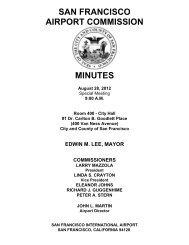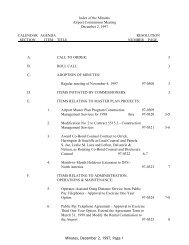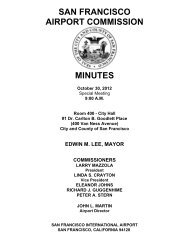Official Statement Airport Commission City and County of San ...
Official Statement Airport Commission City and County of San ...
Official Statement Airport Commission City and County of San ...
Create successful ePaper yourself
Turn your PDF publications into a flip-book with our unique Google optimized e-Paper software.
H1N1 Influenza<br />
The World Health Organization <strong>and</strong> the U.S. Department <strong>of</strong> Health <strong>and</strong> Human Services (through the<br />
Secretary <strong>of</strong> the Department <strong>of</strong> Homel<strong>and</strong> Security), recently declared public health emergencies as the result <strong>of</strong><br />
outbreaks <strong>of</strong> a serious strain <strong>of</strong> H1N1 influenza or flu. The outbreaks occurred initially in Mexico <strong>and</strong> shortly<br />
thereafter in the United States, <strong>and</strong> have spread worldwide. This strain apparently is the first to be communicable<br />
from human-to-human, <strong>and</strong> thus poses a potential risk <strong>of</strong> an international influenza p<strong>and</strong>emic. This flu strain has<br />
caused deaths to many whom were healthy young adults. Travel restrictions, as well as other public health<br />
measures, may be imposed to limit the spread <strong>of</strong> this flu. These outbreaks may lead to a decrease in air traffic, at<br />
least for a temporary period, which in turn could cause a decrease in passenger activity at the <strong>Airport</strong> <strong>and</strong> a<br />
corresponding decline in Revenues. The <strong>Airport</strong> is unable to predict how serious this situation may become, what<br />
effect it may have on air travel to <strong>and</strong> from <strong>San</strong> Francisco, <strong>and</strong> whether any such effects will be material. In spring<br />
2003, there was a similar outbreak <strong>of</strong> a serious strain <strong>of</strong> bird flu in Asia <strong>and</strong> Canada called “Severe Acute<br />
Respiratory Syndrome” or SARS. That, together with the outbreak <strong>of</strong> the war in Iraq <strong>and</strong> other factors at about the<br />
same time, resulted in a temporary but significant decline in passenger activity at the <strong>Airport</strong> <strong>of</strong> approximately 14%<br />
in the second quarter <strong>of</strong> Fiscal Year 2002-03, <strong>and</strong> approximately 7% for the year as a whole.<br />
Climate Change Issues<br />
Possible Sea-Level Rise<br />
In March 2009, the California Climate Change Center released a draft paper, for informational purposes<br />
only, which was funded by the California Energy <strong>Commission</strong>, the California Environmental Protection Agency, the<br />
Metropolitan Transportation <strong>Commission</strong>, the California Department <strong>of</strong> Transportation <strong>and</strong> the California Ocean<br />
Protection Council. The title <strong>of</strong> the paper is “The Impacts <strong>of</strong> Sea-Level Rise on the California Coast.” The paper<br />
posits that increases in sea level will be a significant consequence <strong>of</strong> climate change over the next century. While<br />
noting that impacts are highly site-specific <strong>and</strong> somewhat speculative, the paper indicates that the <strong>Airport</strong> is<br />
vulnerable to flooding with a 1.4-meter sea level rise. The <strong>Airport</strong> is adjacent to the <strong>San</strong> Francisco Bay, which in<br />
turn opens onto the Pacific Ocean. At high tide, most <strong>of</strong> the <strong>Airport</strong> is less than six feet above sea-level. The<br />
<strong>Airport</strong> is presently considering potential mitigation measures, including diking <strong>and</strong> other structural protection, if<br />
they became necessary. The <strong>Airport</strong> is unable to predict whether sea-level rise or other impacts <strong>of</strong> climate change<br />
will occur, when they may occur, <strong>and</strong> if any such events occur, whether they will have a material adverse effect on<br />
the business operations or financial condition <strong>of</strong> the <strong>Airport</strong>.<br />
Possible Increased Regulations<br />
Climate change concerns are leading to new laws <strong>and</strong> regulations at the Federal <strong>and</strong> state levels that could<br />
have a material adverse effect on airlines operating at the <strong>Airport</strong> <strong>and</strong> could also affect ground operations at airports.<br />
The U.S. Environmental Protection Agency (“EPA”) very recently has taken steps towards the regulation<br />
<strong>of</strong> greenhouse gas (“GHG”) emissions under existing Federal law. Those steps may in turn lead to further regulation<br />
<strong>of</strong> aircraft GHG emissions. On April 24, 2009, EPA published a proposed “endangerment <strong>and</strong> cause or contribute<br />
finding” under the Clean Air Act. In the proposed finding, EPA declared that the weight <strong>of</strong> scientific evidence<br />
“requires” a finding that it is very likely that the six identified GHGs – carbon dioxide, methane, nitrous oxide,<br />
hydr<strong>of</strong>luorocarbons, perfluorocarbons, <strong>and</strong> sulfur hexafluoride – cause global warming, <strong>and</strong> that global warming<br />
endangers public health <strong>and</strong> welfare. The proposed rule also finds that GHGs are a pollutant <strong>and</strong> that GHG<br />
emissions from motor vehicles cause or contribute to air pollution. If the proposed rule becomes final, EPA would<br />
be required to regulate emissions <strong>of</strong> certain GHGs from motor vehicles. The Clean Air Act regulates aircraft<br />
emissions under provisions that are parallel to the requirements for motor vehicle emissions. Accordingly, EPA<br />
may elect or be forced by the courts to regulate aircraft emissions as a result <strong>of</strong> this endangerment finding.<br />
Regulation by the EPA can be initiated by private parties or by governmental entities other than EPA. In<br />
2007, several states, including California, petitioned EPA to regulate GHGs from aircraft. On July 30, 2008, EPA<br />
issued an Advanced Notice <strong>of</strong> Proposed Rulemaking (“ANPR”) relating to GHG emissions <strong>and</strong> climate change.<br />
Part <strong>of</strong> the ANPR requested comments on whether <strong>and</strong> how to regulate GHG emissions from aircraft. While EPA<br />
has not yet taken any action to regulate GHG emissions from aircraft, the request for comments <strong>and</strong> proposed rule<br />
on motor vehicles may eventually result in such regulation.<br />
29



